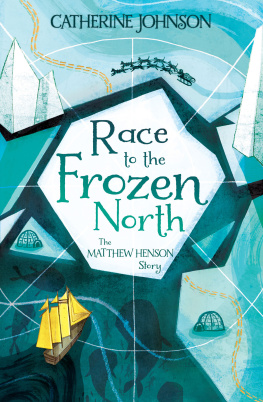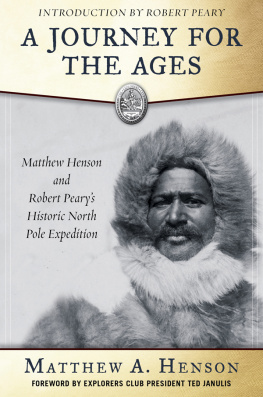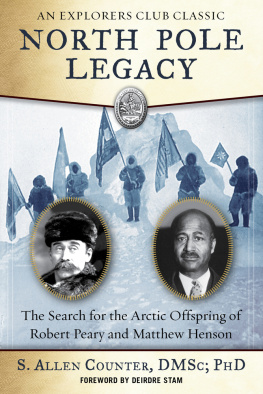
For George Plimpton,
who suggested this story of polar exploration
for a new generation of readers

The Pole discovery is peopled with human romance:
it is part of the epic of man.
L INCOLN STEFFENS

C ONTENTS
A UTHOR S NOTE
E ARLY IN the twentieth century, an international dispute raged over the discovery of the geographic North Pole, the most prized jewel in the crown of human exploration and a goal sought for nearly four hundred years. Following a rancorous public debate that spilled across the front pages of newspapers everywhere, the issue was largely resolved in favor of one American explorer over another, although each claimed to have been the first at the top of the world, where all meridians of longitude meet and the only direction is south.
In the decades since, strong opinions have developed in some quarters that history got it wrong. According to this revisionist analysis, U.S. Navy civil engineer Robert E. Peary, universally credited with having discovered the North Pole on his final attempt, was untruthful about the distances covered on his dash to the Pole and never reached it at all; and the discredited claim of physician Frederick A. Cook to have beaten Peary to the Pole by a year has been accorded increased legitimacy because his detailed descriptions of the North Polethe first ever publishedhave been verified by later explorers. If his claim is true, a grave injustice was inflicted upon Cook, who before the great polar controversy bore a reputation as impeccable as that of any explorer of his time, but who ended up being widely debunked and labeled a charlatan.
The controversy has outlasted both men. Today, there are still individuals and groups claiming expertise in polar affairs who are highly partisan in their support of one claimant over the other, on the basis of available information and evidencescientific, circumstantial, and psychological.
Peary and Cook began as companions drawn by adventure and glory; they ended as bitter rivals. Their desperate efforts to attain the Pole, and, upon their return from the Far North, their equally desperate efforts to secure their place in history were once hailed by journalist Lincoln Steffens as the story of the century. That was a different century, of course, but it remains an extraordinary tale.
THE NORTH POLE IS DISCOVERED
BY DR. FREDERICK A. COOK
NEW YORK HERALD
S EPTEMBER 2, 1909

PEARY DISCOVERS THE NORTH POLE
AFTER EIGHT TRIALS IN 23 YEARS
NEW YORK TIMES
S EPTEMBER 7, 1909
PROLOGUE

1909
A PHYSICIAN FROM Brooklyn and two young native hunters from a northern Greenland tribe, who together had survived the longest dog sledge journey in history and thereafter spent the meanest of winters hunkered down in an ice cave like Stone Age dwellers, were again staring death in the face. Not heard from for more than a year, they had in some circles been given up as lost, and no search parties were looking for them.
On the final leg of an arduous return journey begun the preceding year, the men had been trekking for weeks up the desolate eastern shores of Ellesmere Island in an effort to reach what served as civilization in these latitudes: Greenlands western coast, where food and shelter were to be found.
When they had emerged from their forced hibernation in mid-February, they fought through one storm after another coming off Jones Sound in the Cape Sparbo region. After each storm passed, they encountered ice tumbled into mountainous barriers, which they could skirt only by cutting through tremendous snow drifts, often while fighting gales that made them stagger like drunkards. Even in the long march northward the preceding spring, they had not experienced such difficult travel. Pulling a single sledge strapped to their shoulders because they no longer had dogs, they lightened the load by disposing of unneeded clothing and equipment.
The Arctic was slowly awakening from its long winter night, which at this high latitude meant six months of no direct sunlight and freezing storms, during which temperatures plunged as low as minus fifty degrees Fahrenheit. On their weeks-long trek under skies that had slowly lightened, they saw no living things on the ice to hunt, no seals or walrus or hare, no beefy musk oxen, not even a lone seabird headed elsewhere. They were at the top of the food chain with no signs of life beneath them.
When the last of their provisions were gone, they began eating things not normally considered food. Half of a wax candle and three cups of hot water were served for one meal. Sections of a walrus hide used as a slicker were cut up, boiled, and eaten for several days; although difficult to masticate and causing a few broken teeth, the hide, while it lasted, eased their voracious hunger. Next they cooked and consumed lengths of walrus line.
As subzero winds cut gashes in the exposed skin of their faces, they trudged onward, every fiber of their weakened bodies quivering with cold and hunger. The exertion fueled by limited sustenance caused them to shrivel; under their furs, they were walking skeletons.
On March 20, they discovered that they were not alone. In the twilight illumination that turned the ice an eerie gray, they gathered silently around the tracks in fresh snow of a bear many times larger than a man. They knew about the white semiaquatic bear found throughout the Arctic region. The physician could recite the scientific name, Ursus maritimus , for sea bear. To the Eskimos it was Nanuk, whom native hunters considered the most prized of all the animals they traditionally hunted. An adult male weighed as much as 1,600 pounds, stood six feet at the shoulders, and grew to eight feet in length. Rising upright on its rear legs, as it did when threatened, it soared to an imposing twelve feet or higher. Bears were often found alone on the drifting ice in the spring and summer, swimming from one chunk of ice to the other, feasting on seals they usually caught on the ice. The Eskimos considered the bear a great lonely roamer, possessing wisdom as well as strength. In addition to being an able swimmer, the polar bear was a capable traveler on solid surfaces, with black footpads on the bottom of foot-long paws that gripped for traction. On the ice, the bear moved with surprising swiftness, able to gallop as fast as a horse for short distances. Shy by nature, it was dangerous when confronted, and stalked its prey before racing in for the kill that few escaped. In lean times, it subsisted on seaweed and grass but was carnivorous by nature, with a taste for seals, birds, and caribou. Although only the females hibernated, while the males remained active during the winter, come spring all sea bears were lean and hungry, eager to get on with the eating. Their favored first course: newborn seal pups found cavorting on the ice in early spring. Polar bears had a powerful sense of smell and, when hungry, were known to stalk humans.
The tracks were fresh, meaning that the bear was still in the area and would have little trouble picking up their scent. As yet, they had seen no seals, adults or babies. The bear probably had no better luck. Nanuk would be famished.
Next page









